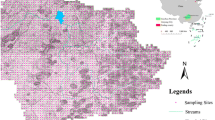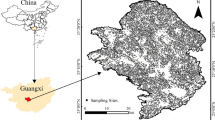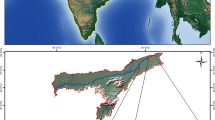Abstract
The spatial distribution patterns of soil organic carbon (SOC) and its relationship with various environmental factors in different topographic features are of great significance for evaluating SOC reserves and carbon pool management in karst areas. In this paper, SOC from the non-karst landforms and four typical karst landforms (karst canyon, karst peak cluster, karst plateau, and karst trough valley) was selected as the research object. The distribution patterns and the driving factors of SOC in the typical landforms were investigated from the topographical and environmental perspectives. The results showed that the average content of organic carbon in non-karst region was 9.39 g/kg, while that in karst areas was 16.31 g/kg. The vertical changes in SOC content showed different patterns in different topographic features, and each layer of the soil profile showed that SOC content in karst regions was greater than that in the non-karst one. The driving factors for SOC varied in different landforms. Specifically, in non-karst and karst peak cluster areas, slope gradient was the key factor influencing SOC. In karst canyon areas, soil thickness was the key factor influencing SOC. In karst plateau areas, land utilization was the key factor influencing superficial SOC. In karst trough valley areas, rock exposure was the major driving factor for karst SOC. These findings could provide an excellent explanation for the factors influencing SOC in karst and non-karst regions in Southwest China.





Similar content being viewed by others
References
Akpa SIC, Aodeh IO, Bishop TFA, Hartemink AE, Amapu IY (2016) Total soil organic carbon and carbon sequestration potential in Nigeria. Geoderma 271:202–215
Baldock JA, Hawke B, Sanderman J, Macdonald LM (2013) Predicting contents of carbon and its component fractions in Australian soils from diffuse reflectance mid-infrared spectra. Soil Res 51:577–595
Cao JH, Jiang ZCJ, Yang DS, Pei JG, Yang H, Luo WQ (2008) Grading of soil erosion intensity in Southwest karst area of China. Sci Soil Water Conserv 6:1–7
Chen Z, Lu CH, Fan L, Wu H (2011) Effects of land use change on soil organic carbon: a review. Acta Ecol Sin 31:5358–5371
Deng L, Zhu GY, Tang ZS, Shangguan ZP (2016) Global patterns of the effects of land-use changes on soil carbon stocks. Glob Ecol Biogeogr 5:127–138
Gabrielle B, Bamière L, Caldes N, Declare S, Decocq G, Ferchaud F, Loyce C, Pelzer E, Perez Y, Wohlfahrt J, Richard G (2014) Paving the way for sustainable bioenergy in Europe: technological options and research avenues for large-scale biomass feedstock supply. Renew Sustain Energy Rev 33:11–25
Herold N, Schning I, Michalzik B, Trumbore S, Schrumpf M (2014) Controls on soil carbon storage and turnover in German landscapes. Biogeochemistry 119:435–451
Hobley EU, Baldock J, Wilson B (2016) Environmental and human influences on organic carbon fractions down the soil profile. Agric Ecosyst Environ 223:152–166
Huang XF, Zhou YC, Zhang ZM (2018) Carbon sequestration anticipation response to land use change in a mountainous karst basin in china. J Environ Manag 228:40–46
Kateb HE, Zhang HF, Zhang PC, Mosandl R (2013) Soil erosion and surface runoff on different vegetation covers and slope gradients: a field experiment in Southern Shaanxi Province, China. CATENA 105:1–10
Kinsey-Henderson AE, Wilkinso SN (2013) Evaluating Shuttle radar and interpolated DEMs for slope gradient and soil erosion estimation in low relief terrain. Environ Modell Softw 40:128–139
Koulouri M, Giourga C (2007) Land abandonment and slope gradient as key factors of soil erosion in Mediterranean terraced lands. CATENA 69:274–281
Li YB, Luo GJ, Cheng AY, Shao JA, Bai XY, Wang SJ (2013) A typical case study on evolution of karst rocky desertification in Houzhaihe, Puding County, central Guizhou Province, China. Geogr Res 32:828–838
Liu MY, Chang QR, Qi YB, Liu J, Chen T (2014) Aggregation and soil organic carbon fractions under different land uses on the tableland of the Loess Plateau of China. CATENA 115:19–28
Martin MP, Orton TG, Lacarce E, Meersmans J (2014) Evaluation of modeling approaches for predicting the spatial distribution of soil organic carbon stocks at the national scale. Geoderma 223:97–107
Pouyat RV, Groffman PM, Yesilonis ID, Hernandez L (2002) Soil carbon pools and fluxes in urban ecosystems. Environ Pollut 116:107–118
Scharlemann JPW, Tanner EVJ, Hiederer R, Kapos V (2014) Global soil carbon: understanding and managing the largest terrestrial carbon pool. Carbon Manag 5:81–91
Shi XZ, Wang K, Warner ED, Yu DS, Wang HJ, Yang RW, Liang Y, Shi DM (2007) Relationship between soil erosion and distance to roadways in undeveloped areas of China. CATENA 72:305–313
Smith P (2012) Soils and climate change. Curr Opin Environ Sustain 4(5):539–544
Taghizadeh-Toosi A, Olesen JE (2016) Modeling soil organic carbon in Danish agricultural soils suggests low potential for future carbon sequestration. Agric Syst 145:83–89
Wang SJ, Liu QM, Zhang DF (2004) Karst rocky desertification in southwestern China: geomorphology, land use, impact and rehabilitation. Land Degrad Dev 15:115–121
Wang YG, Li Y, Ye XH, Chu Y, Wang XP (2010) Profile storage of organic/inorganic carbon in soil: from forest to desert. Sci Total Environ 408:1925–1931
Wang QY, Wang YY, Wang QC, Liu JS (2014a) Impacts of 9 years of a new conservational agricultural management on soil organic carbon fractions. Soil till Res 143:1–69
Wang J, Zou B, Liu Y, Tang Y, Zhang X, Yang P (2014b) Erosion-creep-collapse mechanism of underground soil loss for the karst rocky desertification in Chenqi village, Puding county, Guizhou, China. Environ Earth Sci 72:2751–2764
Wang DJ, Shen YX, Huang J, Li YH (2016) Rock outcrops redistribute water to nearby soil patches in karst landscapes. Environ Sci Pollut Res 23:8610–8616
Wang MY, Xu SX, Zhao YC, Shi XZ (2017a) Climatic effect on soil organic carbon variability as a function of spatial scale. Arch Agron Soil Sci 63:375–387
Wang LJ, Li R, Sheng MY (2017b) Distribution of soil organic carbon related to environmental factors in typical rocky desertification ecosystems. Acta Ecol Sin 37(5):1367–1378
Wang XF, Huang XF, Hu JW, Zhang ZM (2020a) The spatial distribution characteristics of soil organic carbon and its effects on topsoil under different karst landforms. Int J Environ Res Public Health 17(8):2889
Wang XF, Huang XF, Hu JW, Zhang ZM (2020b) Relationship among soil organic carbon and small environment and lithology in the rocky desertification process in different karst landforms. J Soil Water Conserv 34(4):295–303
Weissert LF, Salmond JA, Schwendenmann L (2016) Variability of soil organic carbon stocks and soil CO2 efflux across urban land use and soil cover types. Geoderma 271:80–90
**ong X, Grunwald S, Corstanje R, Yu C, Bliznyuk N (2016) Scale-dependent variability of soil organic carbon coupled to land use and land cover. Soil till Res 160:101–109
Yan X, Li WZ, Luo X, Zhang YR, Huang YY, Qin WN (2020) Study on the vertical distribution characteristics of soil organic carbon under different land use. Agric Technol 40(14):13–15
Zhang X, Bai X, He X (2011) Soil cree** in the weathering crust of carbonate rocks and underground soil losses in the karst mountain areas of Southwest China. Carbonate Evaporit 26:49–153
Zhang LH, **e ZK, Zhao RF, Wang YJ (2012a) The impact of land use change on soil organic carbon and labile organic carbon stocks in the Longzhong region of Loess Plateau. J Arid Land 4:241–250
Zhang W, Wang KL, Chen HS, Zhang JG (2012b) Use of satellite information and GIS to predict distribution of soilorganic carbon in depressions am. Acta Pedol Sin 49(3):601–606
Zhang W, Liu SJ, Ye YY, Chen HS, Wang KL, Wei GF (2013) Spatial variability of soil nutrients and it influencing factors in type karst virgin forest. Trans Chin Soc Agric Eng 29:93–101
Zhang ZM, Zhou YC, Wang SJ, Huang XF (2017) Estimation of soil organic carbon storage and its fractions in a small karst watershed. Acta Geochim 37:113–124
Zhang ZM, Zhou YC, Wang SJ, Huang XF (2018) Spatial distribution of stony desertification and key influencing factors on different sampling scales in small karst watersheds. Int J Environ Res Public Health 15:743–747
Acknowledgements
This work was supported by the first class discipline construction project in Guizhou Province (GNYL[2017]007), the Guizhou science and technology support plan project (No. [2019]2840); The Guizhou science and technology plan project (No. [2020]1Y178); and the project funded by China Postdoctoral Science Foundation (2020M673582XB).
Author information
Authors and Affiliations
Corresponding author
Ethics declarations
Conflict of interest
The authors declare that they have no conflicts of interest concerning this article.
Additional information
Publisher's Note
Springer Nature remains neutral with regard to jurisdictional claims in published maps and institutional affiliations.
Rights and permissions
About this article
Cite this article
Huang, X., Zhang, Z., Zhou, Y. et al. Characteristics of soil organic carbon under different karst landforms. Carbonates Evaporites 36, 40 (2021). https://doi.org/10.1007/s13146-021-00711-y
Accepted:
Published:
DOI: https://doi.org/10.1007/s13146-021-00711-y




